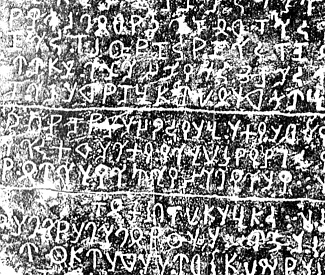

Zitierweise / cite as:
Payer, Alois <1944 - >: Quellenkunde zur indischen Geschichte bis 1858. -- 14. Quellen auf Arabisch, Persisch und in Turksprachen. -- 3. Zum Beispiel: Abū 'l-Faẓl ibn Mubārak <1551 - 1602> (ابو الفضل): Ā’īn-i-Akbarī (آئین اکبری), I.31-32. -- Fassung vom 2008-05-16. -- http://www.payer.de/quellenkunde/quellen143.htm
Erstmals publiziert als:
Abū 'l-Faz̤l ibn Mubārak <1551-1602>: The Ā'īn- Akbarī / [by] Abū 'l-Faẓl 'Allāmī; translated into English by H. Blochmann [1838 - 1878]. -- 2nd ed. / revised and ed. by D. C. Phillott. -- Calcutta : Asiatic Society of Bengal, 1927-1949. -- 3 Bde : Ill. ; 25 cm. -- (Bibliotheca Indica ; work no. 61,270,271). -- Vol. 2-3: translated into English by H. S. Jarrett [1839 - 1919]; corrected by Jadu-Nath Sarkar. -- Bd. I, S. 93 - 102. -- Online: http://persian.packhum.org/persian/main. -- Zugriff am 2008-05-15
Erstmals hier publiziert: 2008-05-15
Überarbeitungen:
Anlass: Lehrveranstaltung FS 2008
©opyright: Public domain.
Dieser Text ist Teil der Abteilung Sanskrit von Tüpfli's Global Village Library
Falls Sie die diakritischen Zeichen nicht dargestellt bekommen, installieren Sie eine Schrift mit Diakritika wie z.B. Tahoma.
His Majesty pays much attention to various stuffs; hence Īrānī, European, and Mongolian articles of wear are in abundance. Skilful masters and workmen have settled in this country, to teach people an improved system of manufacture. The Imperial workshops, the towns of Lāhor, Āgra, Fatḥpūr, Aḥmadābād, Gujrāt, turn out many master-pieces of workmanship; and the figures and patterns, knots, and variety [S. 94] of fashions which now prevail, astonish experienced travellers. His Majesty himself acquired in a short time a theoretical and practical knowledge of the whole trade; and on account of the care bestowed upon them, the intelligent workmen of this country soon improved. All kinds of hair-weaving and silk-spinning were brought to perfection; and the imperial workshops furnish all those stuffs which are made in other countries. A taste for fine material has since become general, and the drapery used at feasts surpasses every description.
All articles which have been bought, or woven to order, or received as tribute or presents, are carefully preserved; and according to the order in which they were preserved, they are again taken out for inspection, or given out to be cut and to be made up, or given away as presents. Articles which arrive at the same time, are arranged according to their prices. Experienced people inquire continually into the prices of articles used both formerly and at present, as a knowledge of the exact prices is conducive to the increase of the stock. Even the prices became generally lower. Thus a piece woven by the famous Ghiās i Naqshband may now be obtained for fifty muhrs, whilst it had formerly been sold for twice that sum; and most other articles have got cheaper at the rate of thirty to ten, or even forty to ten. His Majesty also ordered that people of certain ranks should wear certain articles; and this was done in order to regulate the demand.
I shall not say much on this subject, though a few particulars regarding the articles worn by his Majesty may be of interest.
There are various kinds of each of these garments. It would take me too long to describe the chīrahs, fawṭahs, and dupaṭṭas, or the costly dresses worn at feasts or presented to the grandees of the present time. Every season, there are made one thousand complete suits for the imperial wardrobe, and one hundred and twenty, made up in twelve bundles, are always kept in readiness. From his indifference to every thing that is worldly, His Majesty prefers and wears woollen stuffs, especially shawls; and I must mention, as a most curious sign of auspiciousness, that His Majesty's clothes becomingly fit every one whether he be tall or short, a fact which has hitherto puzzled many.
His Majesty has changed the names of several garments, and invented new and pleasing terms. Instead of jāma (coat), he says sarbgātī, i. e., covering the whole body; for izār (drawers), he says yār-pīrāhan (the companion of the coat); for nīmtana (a jacket), tanzeb; for fauṭa, patgat; for burqa (a veil), chitragupita; for kulāh (a cap), sīs sobhā; for mūy-bāf (a hair ribbon,) kēsghan; for paṭkā (a cloth for the loins), katzēb; for shāl (shawl), parmnarm; for…., parmgarm; for kapārdhūr, a Tibetan stuff, kapūrnūr; for pāy-afzār (shoes), charndharn; and similarly for other names.
His Majesty improved this department in four ways. The improvement is visible,
The garments stored in the Imperial wardrobe are arranged according to the days, months, and years, of their entries, and according to their colour, price, and weight. Such an arrangement is now-a-days called miṣl, a set. The clerks fix accordingly the degree of every article of wear, which they write on a strip of cloth, and tack it to the end of the pieces. Whatever pieces of the same kind arrive for the Imperial wardrobe on the Urmuzd day (first day) of the month of Farwardīn, provided they be of a good quality, have a higher rank assigned to them than pieces arriving on other days; and if pieces are equal in value, their precedence, or otherwise, is determined by the character of the day of their entry; and if pieces are equal as far as the character of the day is concerned, they put the lighter stuff higher in rank; and if pieces have the same weight, they arrange them according to their colour. The following is the order of colours:
In former times shawls were often brought from Kashmīr. People folded them up in four folds, and wore them for a very long time. Nowadays they are generally worn without folds, and merely thrown over the shoulder. His Majesty has commenced to wear them double, which looks very well.
His Majesty encourages, in every possible way, the manufacture of shawls in Kashmīr. In Lāhor also there are more than a thousand workshops. A kind of shawl, called māyān, is chiefly woven there; it consists of silk and wool mixed. Both are used for chīras (turbans), foṭas (loin bands), &c.
I subjoin the following tabular particulars.
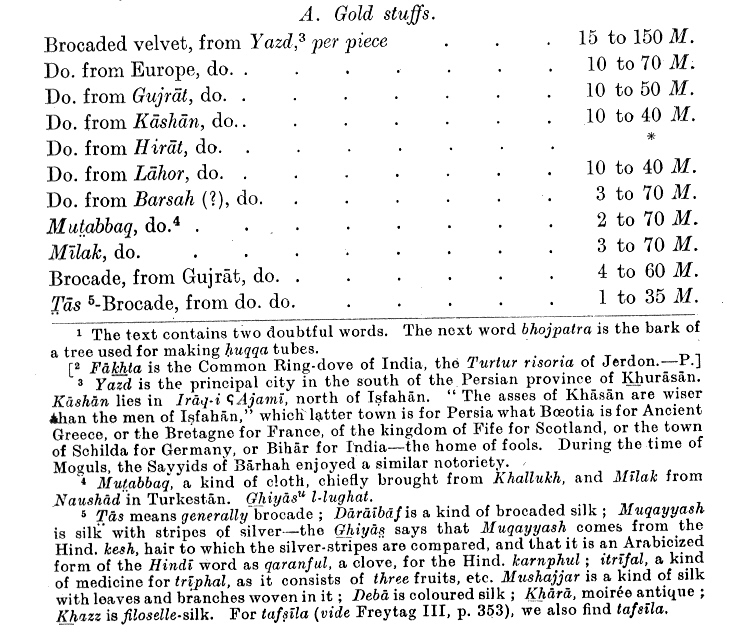
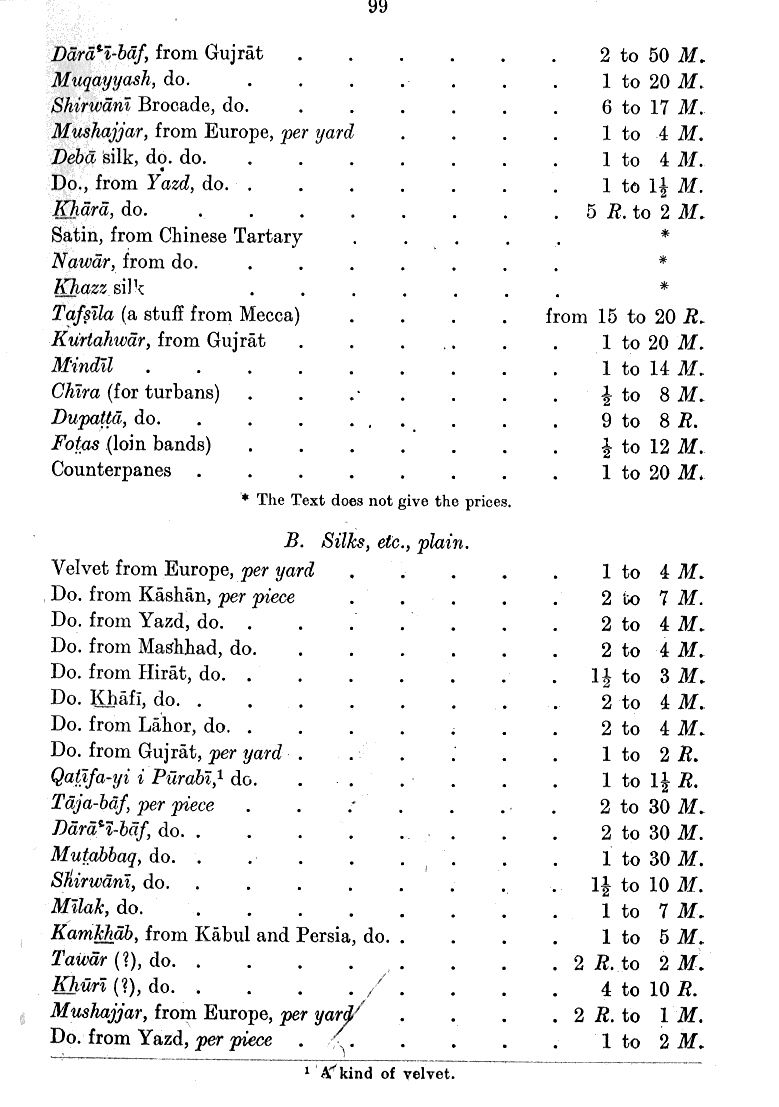
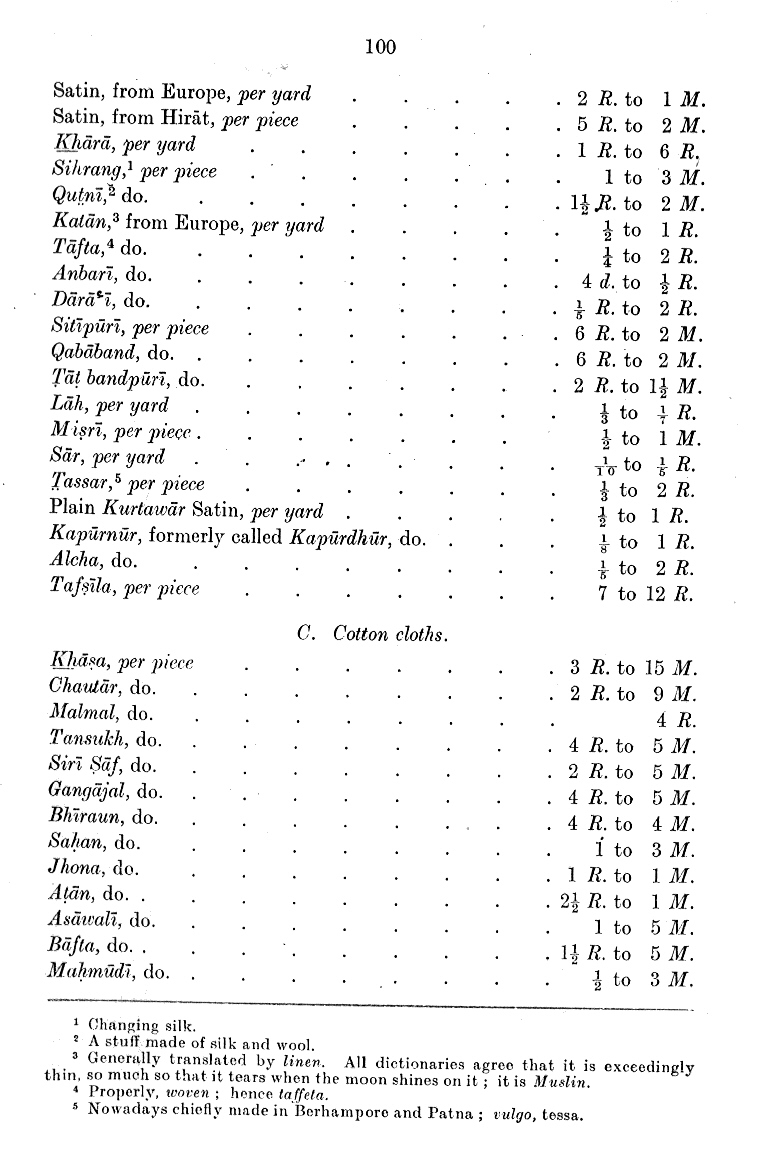
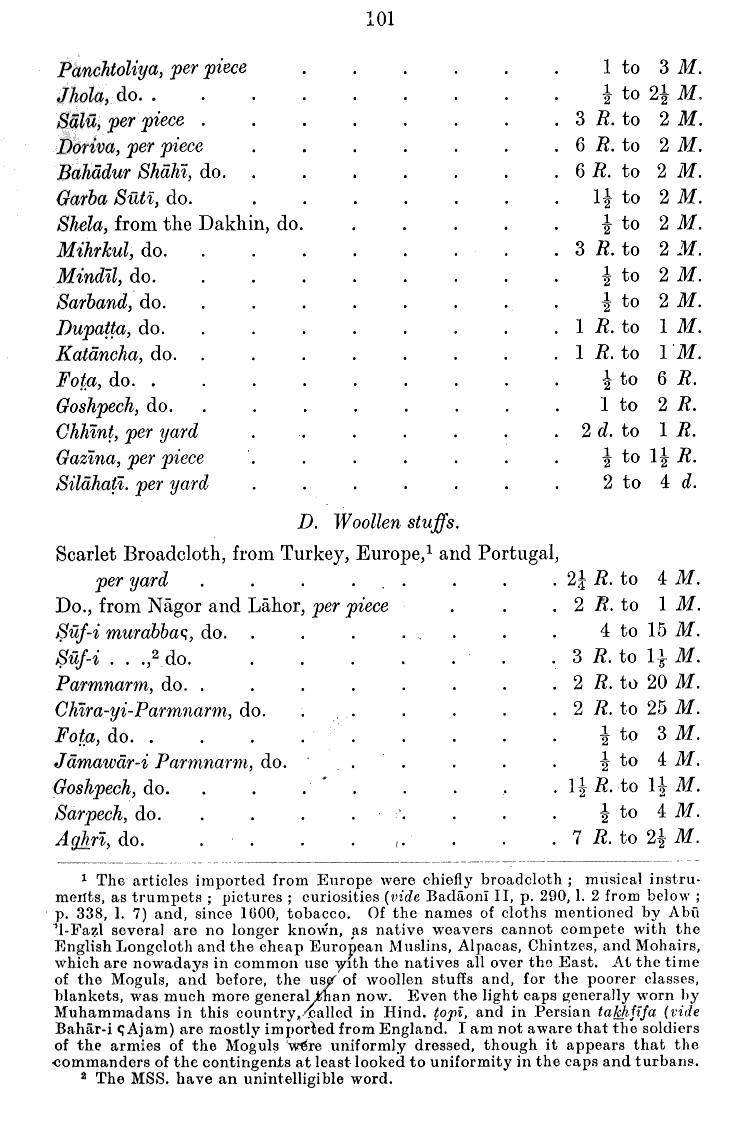
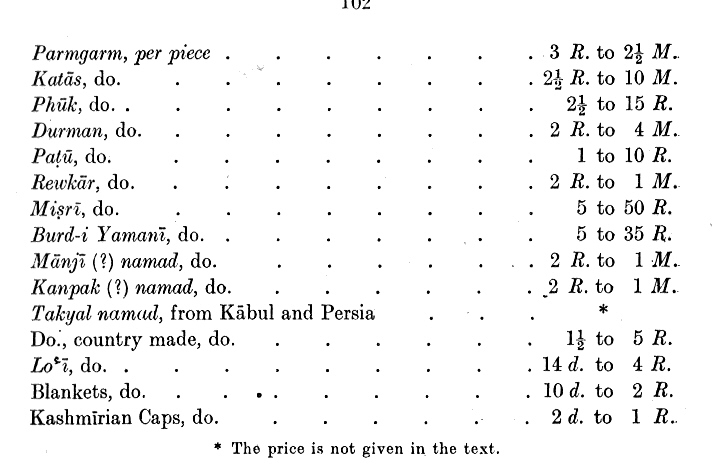
Zu: 4. Zum Beispiel: Abū 'l-Faẓl ibn Mubārak <1551 - 1602> (ابو الفضل): Ā’īn-i-Akbarī (آئین اکبری), I.34 <Auszug>.